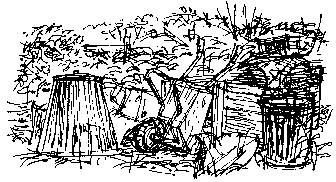
ChicorySaturday 22nd July 2000 WE WERE GIVEN a single plant of Chicory, also known as Succory, years ago. At first we thought that its blue flowers were delightful (it is our only blue-flowered dandelion-like plant). Then we realised that it was starting to become a little too much of a good thing. It spread by underground runners along the narrow bed it was in, then followed cracks in a concrete path to emerge inside the greenhouse. It is now spreading beyond the compost bin.  The woman who gave it to us was a keen gardener and she'd collected seeds of this plant from a lay-by, which I seem to remember she said was near Dalby Forest in the North York Moors. One of the books I've looked it up in says that chicory grows to a little over a foot high. It must enjoy the conditions in our garden because here it grows to shoulder height. The woman who gave it to us was a keen gardener and she'd collected seeds of this plant from a lay-by, which I seem to remember she said was near Dalby Forest in the North York Moors. One of the books I've looked it up in says that chicory grows to a little over a foot high. It must enjoy the conditions in our garden because here it grows to shoulder height.Perhaps our best way to get rid of it would be to dig up the roots; they can be dried and added to coffee, to give it a bitter flavour. The leaves can be blanched and added to salad. It has been used medicinally; Culpepper recommends it for lingering agues, St Anthony's Fire, swooning and passions of the heart (but don't try this at home). The Greeks called it kikhorion.  The Medieval epidemic known as St Anthony's Fire may actually have been caused by ergot poisoning. Ergot is a fungus that attacks rye. In addition to symptoms such as convulsions and dry gangrene, victims of the poison, which is present in infected rye bread, suffer hallucinations. Ergot is the source of lysergic acid, from which the hallucinogen LSD is derived.
The Medieval epidemic known as St Anthony's Fire may actually have been caused by ergot poisoning. Ergot is a fungus that attacks rye. In addition to symptoms such as convulsions and dry gangrene, victims of the poison, which is present in infected rye bread, suffer hallucinations. Ergot is the source of lysergic acid, from which the hallucinogen LSD is derived.Twenty Swifts circle high against a grey sky as we sit outside with our meal, pretending it is a real summer's evening. These are heading north, but it won't be long before they migrate to Africa, leaving before the martins and swallows.
|